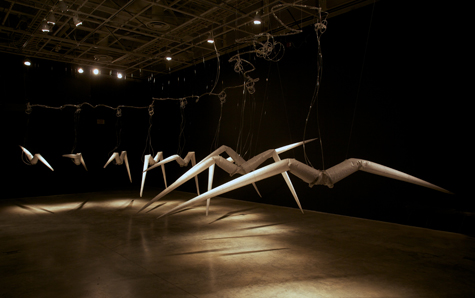Artist Chico MacMurtrie Brings Inflatable Robot Technology to Davis
Rambling somewhere around the axis of where sculpture, engineering, robotics and puppetry collide lays the malleable artworks of Brooklyn-based visionary Chico MacMurtrie. For the past 20 years, MacMurtrie’s anthropomorphic mechanisms have taken on many forms, stimulating commentary on the meaning of movement, of life and of the ways in which viewers are allowed to interact with art, while at the same time examining how art interacts with the world at large.
For reference, take MacMurtrie’s large-scale installation, Birds–showing at the Richard L. Nelson Gallery at the UC Davis campus through Dec. 11, 2011Birds brings together a fleet of elegant bird-like creations, hung in a procession above snaking floor lights meant to represent a river. The installation utilizes some complicated mechanics, computers, a revolutionary inflatable architecture technology created by MacMurtrie himself, and very subtle robotics to produce an interactive demonstration. The inflatable technology, made of a light fabric, essentially allows the avian forms, though loaded with mechanical actuators and machines for movement, to approximate seamless, non-rigid organisms. The “bird” sculptures react to environmental sensors–triggered by the people in the room–by coming to life from a deflated form, to begin beating their wing-like appendages as if flying. Portraying qualities consistent with actual living systems, should a viewer get too close to the sculptures, or spend too much time ogling, they begin to devolve, or die, eventually crumbling back into their stasis one by one.
In short, it’s a provocative commentary on environmentalism, over-population, urban sprawl and more…with robots!
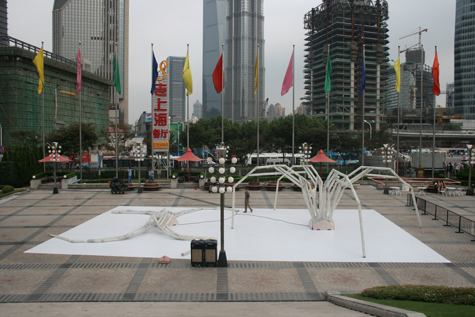
Inflatable Archit Growth Photo: Chico MacMurtrie / ARW
To give an accurate synopsis of MacMurtrie’s robotic sculpture work is nearly impossible, given that the more tangible elements of contemporary art remain satisfyingly absent in his work. Instead, MacMurtrie’s muse is derived from the examination of amorphic shape shifting, using robotics to bring to life geometrically abstract creations–most of them very big–to titillate viewers, and to bring a sense of symbiosis to the art-viewing ritual.
MacMurtrie’s sense of reinvention began during his undergrad college days at the University of Arizona. As a painter, MacMurtrie, 50, says he felt confined by the starkness of the canvas.
“My paintings got more physical, and ultimately I began literally throwing my body into my paintings, using my body as a brush,” explains MacMurtrie. “Ultimately, what I was after was the resulting effect of the paint on my body.”
When the paint had dried on him, the result left a kind of skin. MacMurtrie had an epiphany to move away from painting toward creating transformational performance pieces utilizing body skins. It wasn’t until he took the skins off that the seeds of what MacMurtrie now grows would be sown.

Inner Space - Photo: Chico MacMurtrie / ARW
“Once I emerged out of the skins, I noticed that the skins had a life of their own that was even more interesting and more powerful, in my opinion,” says MacMurtrie. “I began to figure out how to put sub-structures into these skins to animate them.”
MacMurtrie taught himself robotics, and began to see the world in mechanical systems. His new muse was to break down movements mechanically, while utilizing his background in sculpture to form a hybrid of the two. This process began with MacMurtrie’s creation of interactive robotic humanoids in the early ‘90s, collaborating with computer engineers and programmers, and has moved into his innovative work with inflatable robotic architecture. In order for him to progress, MacMurtrie literally had to reinvent the way the processes of construction and implementation were approached for his work–to move beyond robotic automation, and into abstract robotic sculpture.
Simply put, he’s not an engineer. But that doesn’t bother him.
“If I would have gone to engineering school, it would have inhibited [me],” says MacMurtrie. “Often, I’m doing things that are extremely difficult and challenging. People who have a practical understanding of engineering wouldn’t take those things on. I end up creating more work for myself because I’m not an engineer, but it’s more of a genuine process, I think.”
With lots of funding help, due in no small part to five grants from the National Endowment for the Arts, as well as funding from national, local and international granting agencies and 30 corporate sponsors, MacMurtrie and his collaborative group of artists, technicians and programmers–Amorphic Robot Works, founded in 1991–have created more than 250 mechanical sculptures that assume anthropomorphic and abstract forms that have been shown all over the world.
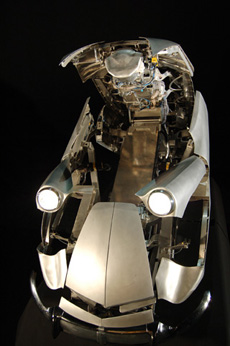
Totemobile - Photo: Chico MacMurtrie / ARW

Totemobile - Photo: Chico MacMurtrie / ARW
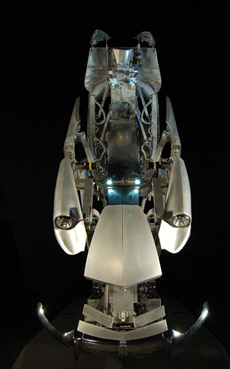
Totemobile - Photo: Chico MacMurtrie / ARW
Big examples of this work include Totemobile–a robotic sculpture that in its settled form appears as a life-sized representation of a 1965 Citroën DS automobile. During the performance process, the sculpture is disassembled robotically, growing slowly from the inside out to finally bloom into an organic 60-foot-tall totem pole. The result–which utilizes the inflatable technology–is a stunning pseudo-Transformers study of pop culture idolization and the inner-workings of organic labor that any construct of man was forced to endure.
With Birds, MacMurtrie tried to create an in-between point from Totemobile, and his early humanoid robots.
“[The birds] could be legs, they could be cones. They are certainly abstractions of birds,” explains MacMurtrie. “People see them as birds because they appear to have wings, and they appear to live and die, and they appear to take flight. They also have a pattern of becoming unified, then falling out of order. It resembles nature. It’s not so important that they are literally birds to me, as much as [viewers] get a sense of: they’re organizing the way nature organizes. They fall apart the same way that nature tends to fall apart.”
MacMurtrie says that the birds have received different reactions the world over. And while the abstractness of his work is true in a geometric sense, his hope is that it inspires people to think beyond the mechanics of his creations.
“The most important thing is that it’s alive, it has a life force, it’s trying to organize itself and trying to find its structure,” says MacMurtrie. “There’s a lot of social commentary [in Birds], but it’s extremely subtle. The birds work pretty much the same way we do. The difference is they’re fueled by air, and if we can’t breathe, we don’t live, and if we don’t eat fuel, we certainly don’t live. In this case, their air is fueled by electricity. It’s similar or parallel to our living.”
Birds shows at the Richard L. Nelson Gallery at Nelson Hall at UC Davis through December 11, 2011. Gallery hours are Monday through Thursday, Saturday and Sunday 11:00 a.m.—5:00 p.m. and by appointment Fridays. Call (530) 752-8500 for more information. For more about Chico MacMurtrie, visit Amorphicrobotworks.org.
On the art of Danny Scheible
Words by Bobby S. Gulshan
In the last few months of 2010, Sacramento’s Second Saturday Art Walk emerged as a hotly contested locus of debate. People wondered out loud if the event had strayed from its original mission; was the benefit to Midtown businesses and artists enough to justify the risks? Because opinions abound on both sides, we will likely not see any significant change to the Second Saturday event any time soon.
One thing, however, stood seemingly beyond contention: the art community is an important and integral part of the Midtown scene and of Sacramento in general. The amount of activity within the visual arts in Sacramento defies the notion that a vibrant art community that generates meaningful and important work can only exist within the major metropolises of New York or Los Angeles. To be sure, those cities remain important cultural centers if for no other reason than the sizes of the markets they inhabit. Yet, as artist and sculptor Danny Scheible tells it, there is something special about making art in Sacramento.
“You meet people here and they want to help you,” he says. “There is a community already there. Having been to bigger cities, it’s very much an exchange, what can this person do for me?” This sense of community, of art as the beginning of a practice of going beyond oneself, or perhaps toward some more complete version of the self, resonates centrally in Scheible’s work.
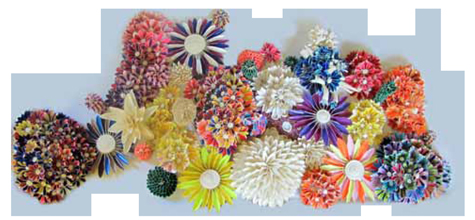
In sculpture, materiality and spatial context play vital roles in the interaction of the art object and its observer. As Danny and I spoke, he crafted flowers and other more abstract objects from rolls of masking tape. “Tape is something that everyone has in their house or wherever, so it’s something people can immediately identify with,” he says. “But it’s also about taking that everyday object and seeing the aesthetic potential in it.”
This intentional choice represents a movement toward the audience, toward their cultural and social location. With respect to spatial location, Scheible sees the importance not just of the gallery setting but of public space. While it brings with it some level of anxiety (things being damaged, openly criticized) venturing into public space is a further gesture toward the audience. In this case, it is to de-familiarize the everyday and punctuate it with an aesthetic gesture. “I might put a small piece out somewhere and then stand across the street and watch and see how people react, or I may leave things along my walking paths,” he says. Scheible will chronicle reactions, and these impressions further inform his process. In this way he is, as he says, “constantly creating myself as a person through my art.”
Scheible is the self-proclaimed “Art Ambassador of Sacramento.” His primary diplomatic function seems to be to inject into the experiences of his artwork–and thus himself–a dialogue or process by which further discovery can be made. “It’s a spiritual or meditative practice,” he says.
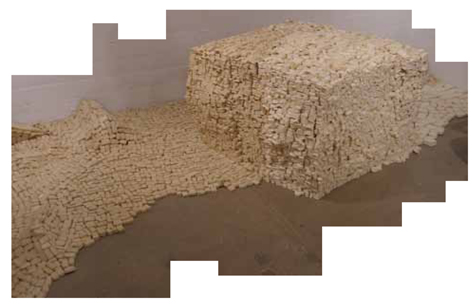
Many of our notions concerning modern sculptural works come from either our experience of sculptural objects in a gallery setting or the placement of sculptures in public places such as parks or commercial centers. These experiences tend to remind us of a kind of critical distance that exists between the object and the observer. In the case of minimalist sculptural works, the movement of the observer is a sort of theatrical gesture, but the object remains mute, having no specific relation to the audience other than its spatial fixedness. Scheible’s entire practice, and indeed process, seeks to reinvigorate this relationship with a certain kind of intimacy. In the works that he has given away, Sheible has encouraged others to produce drawings of his work that may subsequently be used as screen-print images, or alternately as hand drawn images, which again become the subject of his own process, as a sort of perpetual feedback loop. And this is key: The constant dialogue, or even dialectic, that generates the self through the process of offering forth the piece, having it reflected, and then taking that reflection as the starting point for the next iteration of work.
Scheible tells me, “I was born and raised in Curtis Park, and I live here now.” Locality is key to his process. The dialogue with the audience requires an immediacy that his interventions in space reveals. However, I don’t suspect that if Scheible keeps it up for long his bounds will be geographically limited. There exists a crucial point at which his art dares to reach into a universal realm: “An artist isn’t something you are born as, it’s something you make yourself into.” For Sheible, this is as much material and spatial as it is social. As he tells it, his strength lies in getting other artists to work together, to show together, and to promote together. This is a fundamental characteristic of anyone who dares to push the art that they believe in to the fore, and make it geographically and socially relevant.
We could have spent hours talking about the importance of public versus private space, or how hard it is for an artist to fix the damn scooter when it’s wrecked. But I look forward to an upcoming solo show, and the show he is curating, all here in our ever-vibrant Midtown arts scene.
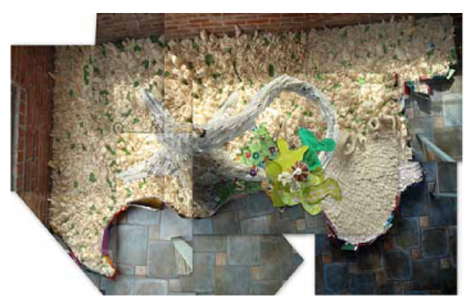
Danny Scheible’s latest solo show at Lauren Salon will have its opening reception during Second Saturday in March (March 12, 2011). Scheible’s curated show will take place at FE Gallery and will also have its opening reception on Second Saturday in March from 6 to 9 p.m.
May Izumi brings her fantastical sculptures to Davis
I take great pleasure in escaping to a fantasy world that I have created in the dark chasms of my mind. Many different forms of media fuel my strange utopia: literature, film, music and in the case of May Izumi—sculptures. A Honolulu, Hawaii, native, Izumi’s sculptures depict otherworldly creatures and figures that peer out from pensive eyes and stand with alluring postures that dare you to come in and look closer. Turns out, Izumi is a lot like me—searching the depths of her mind and referencing the words and illustrations of childhood stories and fairytales to create a world of animal hybrids.
Unlike an illustrator of an intricately woven fantasy, Izumi’s preparation doesn’t begin in a sketchbook with a set of colored pencils and an eraser. She prefers longhand.
“I’m an editor, so I actually write stuff out first. Sometimes it’s just words, sometimes it’s phrases,” says Izumi of her process. “In art school, I got into trouble because I didn’t really have a sketchbook, and they couldn’t read my handwriting.”
Her art education had a rocky beginning. Izumi floated through art classes and found no real connections with her classmates (who were much younger) or with the media involved. After having little success trying to paint, some friends suggested potting. Clay was no different—at first.
“I was a terrible potter,” jokes Izumi.
Most would give up, move on and shoot for a business degree instead, but Izumi continued with clay and realized she was good at hand building. She eventually found her niche in sculpture art after, ironically, she ran out of art classes to take. She went out on her own and did some research, seeking out the work of other figure artists to reference. In fact, some of these artists were alumni of the John Natsoulas Gallery, where Izumi and Boyd Gavin will be showing later this month.
“Most of the people that I admire have work in his gallery,” says Izumi.
Izumi’s work is a combination of a refined color palette, the use of found objects and an attention to the detailed gestures that each of her characters possesses. Izumi ties all these elements together carefully and methodically in order to achieve what others have described as worn and vintage.
“I’m not a big fan of bright colors,” she says. “I don’t know if it’s because I’m a hopelessly conservative Japanese American. I like the worn-out looking colors.”
Her tattered and lonely-looking sculptures have a connection with people who see something of themselves in the scarred, oddly shaped figures. A friend of Izumi’s who had struggled with drugs and spent some time in and out of jail told Izumi that her sculptures looked like “they had a lot of trouble but were still here.”

There is a story inside the work that Izumi is trying to tell. It is a story of struggle and of those trying to work their way out of a rut and do better for themselves. It is the message that she has read between the lines and heard in the small and quiet conversations in the halls of the University of Hawaii where Izumi works as an editor for the School of Ocean and Earth Science and Technology. However, it isn’t earth science and oceanography images that she references as having an impact on her work; rather, it’s the people around her.
“We have 700 faculty at the school. I’ll pick up things that people have said or things that people tell me. I’ll get ideas,” explains Izumi.
Izumi begins with a wire frame that she shapes into her skeletal frame. Then, depending on the piece, she might use newspaper to add girth that she then coats in an aluminum foil wrapping. She compares the appearance of her creatures in this pre-clay state as “cryogenic corpses.” The clay she uses is pricey, about $10 for a package roughly the size of a stick of butter, so mistakes can be costly—it usually requires about three or four sticks to cover the entire area of a sculpture. Once that is finished she coats them in sepia ink and then goes over that with the color. This layering process is what gives some of the sculptures the appearance of leather.
The found objects in Izumi’s sculptures also add an extra depth to her work and help the sculptures venture beyond the formation of clay. Izumi salvaged beakers that the university was tossing out, and she used them for a series of pieces that featured endangered and extinct birds. The sculptures were inspired by a show she did with a friend who was working on a project about endangered animals. It struck a nerve with Izumi.
“I find it fascinating that there’s this bird that used to be alive and now it’s gone forever,” she says. “And all we have is this thing in a glass tube to make a new one. I don’t think it will ever be the same.”
For someone who has a full-time job, a limited art education and no real Web site, Izumi has still managed to produce a complete and studied body of work that has all the right components. At 45, Izumi’s future appears bright with her upcoming West Coast appearance and a show planned for next year in Honolulu, where she currently resides. She’s moving at her own pace, a self-proclaimed slow worker; and frankly, it’s worth the wait.
May Izumi’s thought-provoking creations will be on display at the John Natsoulas Gallery in Davis this month along with realist and still life painter Boyd Gavin. The exhibit will run from Jan. 27 to Feb. 20, 2010. An opening reception will be held on Feb. 6 from 7 to 9 p.m.

